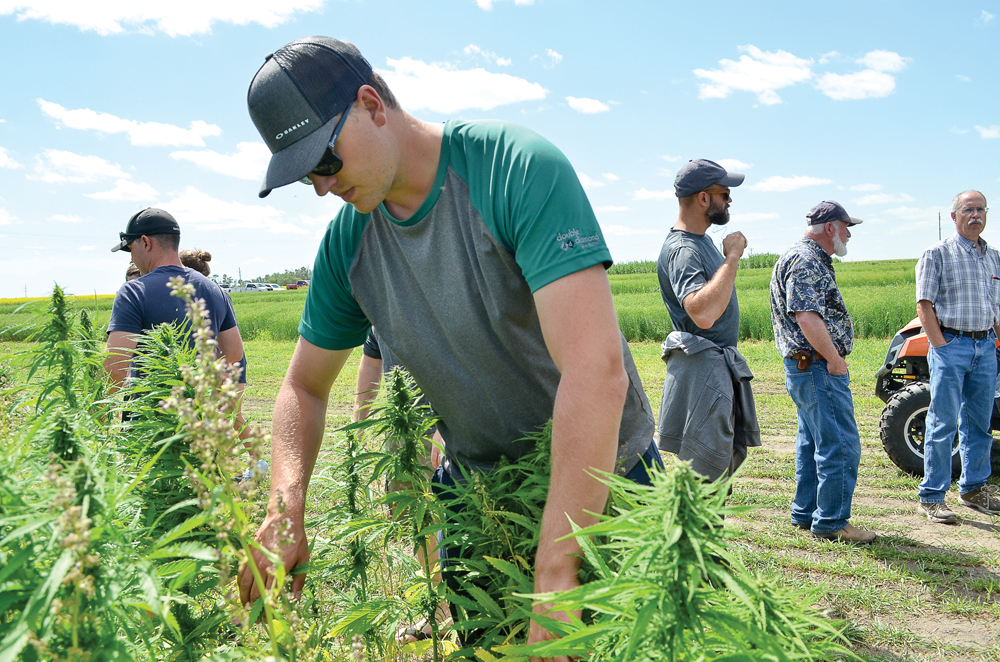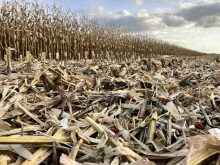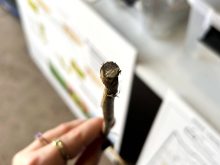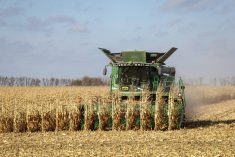There are some unusual crop combinations springing up southwest of Melita.
Experimental intercrops are among the Westman Agricultural Diversification Organization (WADO) projects this year, including flax intercropped with soybeans and hemp intercropped with legumes. Pea-canola, an emerging combination already used on some Manitoba farms, and the already established wheat-legume mix are also under the microscope, with an eye to best management practices.
Intercropping trials were on display during the July 25 WADO field day.
First-time combos
One of WADO’s more experimental mixes, Manitoba Agriculture diversification specialist and WADO manager Scott Chalmers said, is flax and soybeans. They were grouped at least partially for disease control and to explore yield effects.
Read Also
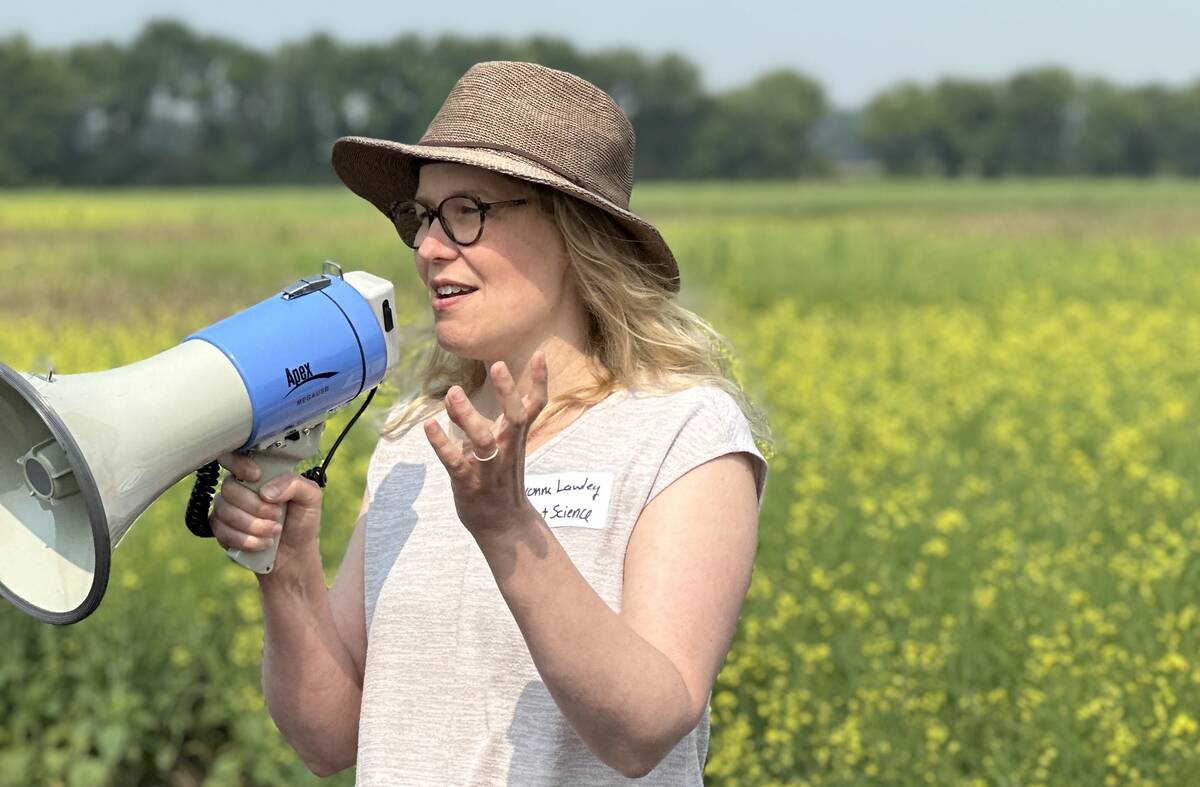
Cereal cover crops show mixed flea beetle protection for canola
University of Manitoba researchers are testing if planting fall rye and oat nurse crops help growers reduce damage without hurting yield.
Crop maturity lines up well between the two crops, he said, and both share a number of registered herbicides for a range of weed groups, easing weed management.
“The main idea is just to observe overyielding, which is traditionally seen in intercropping,” Chalmers said. Overyielding is the additional production observed from a community of plants, when compared to the same crops in a monoculture.
Previous research has introduced flax as a “nurse” crop when intercropped with other pulses. Results out of Saskatchewan’s South East Research Farm in 2014 found that a chickpea-flax intercrop showed a 17 per cent instance of chickpea aschocyta, compared to 51 per cent in monocrop plots.
WADO researchers will examine how flax and soybeans growing together affect soil nutrition and any impact on seed quality, Chalmers told the crowd July 25.

Farmers should avoid dropping the mix into their own rotations until the impacts of the combination are better known, he added.
In particular, WADO staff are concerned that soybeans will be shredded during harvest.
“The one thing that’s not working out is whether we can thresh soybeans and keep them relatively intact while threshing flax, which requires a much faster speed for the combine,” Chalmers said.
Hemp-legume intercropping is also on the field for the first time at WADO this year.
Hemp was planted either alongside or ahead of sweet clover, alfalfa, hairy vetch, red clover and field peas.
“This was more of a last-minute trial,” Chalmers said. “One of our board members was concerned that their residue after hemp harvest is not breaking down fast enough and that it can be quite cumbersome to try and deal with that residue because hemp is so prolific. The idea with the legumes is to see if we can break down that residue from the hemp faster by having something covering the ground that’s more of a living material that’s producing more nitrogen.”
The mix may also mitigate wet springs through post-harvest green cover and legume regrowth in spring, much like the more common wheat-legume intercrop (also on trial at WADO this year), Chalmers said. The added forage production is another perceived advantage.
WADO has shown interest in the agronomic impacts of a hemp-legume crop, including longer green cover, more pollinator habitat and nitrogen credits to the soil. A high-nitrogen crop, hemp removes about 200 kilograms of nitrogen per hectare, according to Manitoba Agriculture.
Hemp and peas have been less successful this year as the companion crop largely overtook the chosen, shorter, hemp variety, Chalmers told the crowd. Hemp is holding ground against other legumes, he said, although that may change as the male hemp plants die back, opening the door for underlying legumes to compete.
Management practices
As well as exploring new ‘breakout’ combinations, WADO is also diving a bit deeper into more proven mixes, such as examining the impact on soil nutrients from pea-canola intercropping.
“This has been a burning question for us,” Chalmers said. “We know we can overyield, but with that overyielding are we requiring more nutrients per acre such as phosphorus?”
Last year’s results showed phosphorus application resulted in higher yields, while nitrogen applications saw nodulation and overall pea performance decline. Canola, bolstered by additional nitrogen, quickly outcompeted peas.
Chalmers pointed to previous research, which has shown that nitrogen will inhibit pea nodulation.
“We just wanted to put it to the test here, and certainly that’s what we’re seeing, but we don’t know what the behaviour of the two crops together is on sharing that nitrogen,” he said.
It is unclear if additional nitrogen bolsters canola enough that it makes up for any loss in peas economically.
Pea-canola trials have shown an average 20 per cent gain over monoculture plots of both crops, Chalmers said, while the research farm also noted fewer aphids in the intercropped plot than in peas alone, although the reason for that change is not known.
In terms of herbicide, he noted, there are available herbicides which are compatible for both crops.
Farmers using the mix have complained that the pea-canola intercrop is difficult to harvest. Chalmers acknowledged the challenge and advised farmers to use a chemical desiccant and harvest the standing crop. The intercrop limits pod shatter risk in chemical desiccation, he said, as pea tendrils are tangled with canola, keeping the canola crop in place.
“The idea is that with the peas clinging onto the canola, the peas are actually off the ground and easier to harvest in a pea-canola situation than they would be in a monocrop situation where peas generally fall on the ground and you need special lifters to peel them off the dirt and get them into the combine,” he said.
WADO mixed an early-season canola with late-season peas to better match maturity.
Legumes and wheat
Intercropping hard spring red wheat with legumes is not a new concept, but Chalmers hopes more data will draw a better line on management.
WADO’s ongoing wheat-legume trial tests different legumes (such as alfalfa and clover) broadcast at different times relative to wheat crop.
“We don’t have a good handle on how to establish those clovers or alfalfas underneath the wheat, whether we need to pre-broadcast our seed and then seed into that or put it down with the wheat seed at the same time or to wait after, till we’ve seeded wheat when we have more black dirt and then broadcast into that,” Chalmers said.
The experiment, now in its second year, saw little difference in stand count between seeding systems last year.
The project measures early plant counts, yields and fall biomass. Chalmers said WADO could also measure the legume’s overwinter survival, but noted there might be logistical issues with accessing the field next spring.


